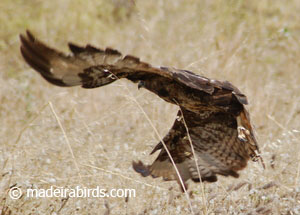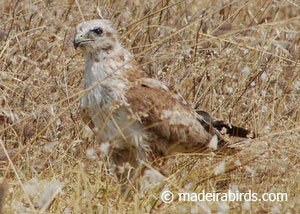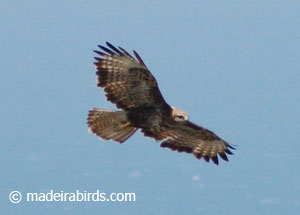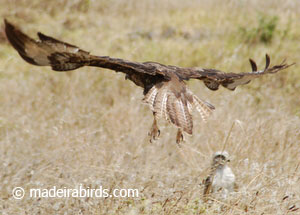Common Buzzard Buteo buteo buteo (Linnaeus, 1758)
Order: Accipitriformes Family: Accipitridae Status: Breeding in Madeira
Recommended birdwatching tours to watch this bird
Full-day birdwatching
Half-day birdwatching
Laurel Forest Tour
Common Buzzard Field ID Keys
Shape & Size
Medium-large size raptor with broad, round and long wings with a short neck. It has a short and roundish tale.
Colour Pattern
Its colour is very variable though with a fairly constant pattern.
The Buzzard’s feet are yellow and feather-free. When the bird is in flight, small, lighter coloured bars on its rounded wings and on its tail feathers contrast with the bird’s overall dark tone.
Behavior
The Buzzard generally glides in wide circles, taking advantage of rising currents of warm air.
Habitat
Common Buzzards are found in different habitats such indigenous and exotic forests, areas with sparse or creeping vegetation, agricultural areas and human settlements. Buzzards are relatively common throughout the island of Madeira. Although it is also found in Porto Santo it is much less common.
Distinction from similar species
Buzzard is easily identifiable since it is larger than any other breeding bird found in Madeira, though sometimes we get some vagrant eagles and other buzzards so it might be confused with Long-legged Buzzard Buteo rufinus which is bigger (the largest buzzard) with longer wings and legs. The later can be separated from Common Buzzard by its dark belly patch contrasting with its pale head and remainder underparts.
Curiosities
In the past, this bird of prey was also found on Desertas islands, however, these birds disappeared at the time of the project for restoring the land habitat of the Deserta Grande island, in spite of the fact that the Common Buzzard was not a target species.
Buteo buteo Biometrics
Wingspan: 115 - 135 cm (Beaman & Madge, 2011)
Total length: 51 - 57 cm (Beaman & Madge, 2011)
Weight: 550 - 1200 g (Hume, 2002)
Other Bird Facts
Seasonality in Madeira: All year
Breeding: The Buzzard nests high up, in densely vegetated ravines or in tall trees, so that it always has a wide field of view from the nest and can spot any approaching danger. The nesting pair starts building the nest in February and begins incubating the eggs (two or three) in mid-April / May. The young birds are ready to leave the nest, three to four months later.
Diet: In Madeira they feed mainly from rats and rabbits though it can also feed on beetles, earthworms and some birds.
Status
Madeira local status by Correia-Fagundes et al, 2021: Common breeding bird
Madeira local status by Romano et al, 2010: Common breeding bird
Madeira local status by Zino et al, 1995: Very Common breeding bird
Conservation status by the IUCN Red List Categories, 2013: Least Concern ver 3.1
Name of this species in other languages
Madeira: Manta
Portuguese: Águia-d'asa-redonda
German: Mäusebussard
Dutch: Buizerd
Swedish: Ormvråk
Danish: Musvåge
Finish: Hiirihaukka
Norwegian: Musvåk
Spanish: Ratonero común
French: Buse variable
Italian: Poiana eurasiatica
Polish: Myszołów
Slovak: Myšiak hôrny
Czech: Káně lesní



